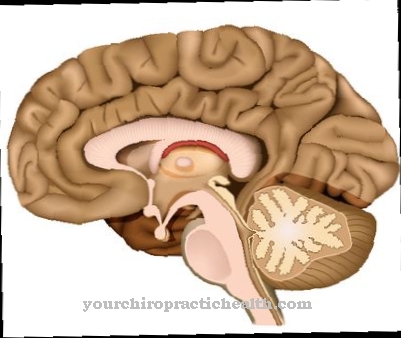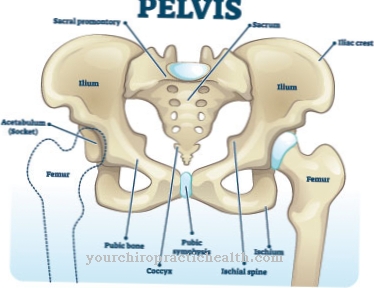In the Conductive hearing loss there is a disturbance in the transduction of sound from the air. The patients hear all the noises of everyday life only to a reduced extent. Therapy depends on the cause and ranges from drug therapies to plastic surgery.
What is conductive hearing loss?

© vishalgokulwale - stock.adobe.com
There are mainly two different forms of hearing loss. Either the sensation of the sound is disturbed or the sound conduction is disturbed. In the Conductive hearing loss the latter is the case. The phenomenon is also called Middle ear hearing loss designated. In the broadest sense, this concerns all hearing impairments based on impaired sound transmission within the outer ear area or the middle ear.
In the ear, sound from the air is transformed into an action potential by a mechanical chain consisting of the eardrum, the ossicles and the labyrinth, which can be processed by the nerve fibers.This process corresponds to transduction. Conductive hearing loss is basically a transduction disorder. In the case of sensorineural hearing loss, however, there are sensory or neural disorders. Often this form of hearing loss is called Inner ear hearing loss designated.
Conductive hearing loss can have various causes and is now well treatable. The prevalence of hearing impairments in need of treatment for Germany is given as 19 percent. Up to 30 percent of all hearing impairments should correspond to conductive hearing loss. In contrast to neuronal sensory hearing loss, conductive hearing loss usually does not manifest itself in old age, but in far earlier decades of life.
causes
The causes of disturbances in sound conduction in the sense of conductive hearing loss are variable. Possible causes are, for example, malformations of the auricle, as they occur in congenital form and are often present in the context of malformation syndromes. The primary cause of this type of congenital malformation is most often a genetic mutation. Malformations of the ear canal can also cause conductive hearing loss.
This phenomenon also makes up some malformation syndromes and can be genetically caused. Acquired conductive hearing loss, on the other hand, is often the result of an ear wax plug or a foreign body in the ear canal. These types of hearing loss are just as reversible as conductive hearing loss due to an inflammation of the ear canal.
Conceivable causes for acquired forms are also the tube occlusion and the middle ear effusion in the sense of a tympanic effusion. Conductive hearing loss after scarring in the middle ear or distortion of the auditory ossicles, such as those caused by injuries such as a fractured skull, is irreversible.
Conductive hearing loss can also be due to a hole or a tear in the eardrum. Other possible causes are otosclerosis, otitis media and cholesteatoma.
Symptoms, ailments & signs
Patients with any type of conductive hearing loss have less hearing. They perceive all noises in everyday life much more quietly than healthy people. For example, many patients with conductive hearing loss perceive conversations as exhausting because they have to concentrate extremely to perceive. The quality of the noises is irrelevant for conductive hearing loss.
The patients perceive both high and low tones at a reduced volume. In many cases, those affected describe conductive hearing loss with the subjective feeling of hearing through cotton wool or a similar barrier or of wearing ear plugs in their ears during the hearing process.
The symptoms accompanying the hearing loss depend on the cause of the conductive hearing loss in the individual case. For example, inflammation causes pain. In the case of congenital malformation syndromes, conductive hearing loss in the context of a malformed auricle can be associated with many other malformations of the body.
Diagnosis & course of disease
To diagnose conductive hearing loss, an otoscopy is performed, which can depict injuries to the eardrum, ear wax or other foreign bodies in the ear canal and phenomena such as middle ear effusion. There is also a Weber test. The doctor strikes a tuning fork and places it on the top of the head of the patient, who perceives the sound louder in the hard of hearing in the case of conductive hearing loss. In addition, a negative Der Rinne attempt is pathologically negative.
The tympanogram is used to determine the mobility of the eardrum and allows conclusions to be drawn about the pressure conditions in the ear. This examination can detect, for example, a tympanic effusion or a ventilation disorder. Disturbances in bone and air conduction can also be distinguished in the tone threshold audiogram. This test can be used to differentiate sound conduction from sensorineural hearing loss through differential diagnosis. The prognosis for people with conductive hearing loss depends on the cause.
Complications
People with conductive hearing loss often have to limit themselves considerably in everyday life. Carrying out the job is usually no longer possible and everyday things, such as shopping or talking, turn out to be difficult. The impaired hearing is accordingly associated with stress, which represents an additional burden for those affected.
Major complications can occur if the patient can no longer perceive traffic due to the hearing loss. The risk of an accident is then increased and many of those affected withdraw as a result and develop mental suffering. Conductive hearing loss usually does not cause physical complaints. In the case of congenital malformation syndromes, however, inflammation and other complaints in the area of the ear can occur.
In addition, the cosmetic blemish can favor the development of inferiority complexes. Drug therapy for the disease can have side effects and interactions. Nasal sprays can lead to inflammation of the nasopharynx. Under certain circumstances, the sick develop an addictive behavior and as a result suffer from the long-term side effects of the corresponding preparation.
Surgical treatment carries the usual risks: infections, bleeding and wound healing disorders. Even years later, skin rejection reactions can occur. Incorrectly adjusted hearing aids occasionally cause further damage to the ear. Inflammation and balance problems cannot be ruled out either.
When should you go to the doctor?
Medical treatment is always necessary for conductive hearing loss. As a rule, self-healing cannot occur. In the worst case, conductive hearing loss can lead to complete deafness if left untreated. The earlier the disease is detected, the better the further course. A doctor should be consulted if the patient can only hear very poorly. He has to concentrate extremely on the conversation or on certain noises in order to be able to perceive them.
The quality of the sound also decreases significantly. In some cases, a malformation of the auricle can also indicate conductive hearing loss and should also be examined by a doctor. These symptoms can occur especially after an accident or after very loud noises and must be examined by a doctor. Conductive hearing loss can be diagnosed by an ENT doctor. Further treatment depends on the exact cause of the conductive hearing loss, so that no general course can be predicted.
Treatment & Therapy
The therapy for conductive hearing loss depends on the primary cause. For some conductive hearing loss, causal therapies are available, depending on the cause. For example, foreign bodies in the ear canal can be removed. The cause of the hearing loss is then eliminated and the hearing loss cured. An earwax disorder can be resolved therapeutically quickly and manually.
In the case of ventilation problems in the auditory tuba, conservative medication therapy with decongestant nasal spray takes place and the hearing loss is also cured. A causal tympanic effusion requires a somewhat more complex causal therapy. With a cut in the eardrum, the doctor provides relief and allows the ear secretions to drain away. In this case, too, the hearing loss is eliminated once its cause has been resolved and the cut heals by itself.
However, if the hearing loss has more serious causes such as otosclerosis or destruction of the ossicles, complex therapy methods are indicated. In these cases, treatment takes place using surgical procedures. A stapesplasty or tympanoplasty is performed on destroyed auditory ossicles. Hearing aids can also be used, especially in the case of congenital conductive hearing loss.
You can find your medication here
➔ Medicines for ear complaints and hearing problemsprevention
Conductive hearing loss caused by foreign bodies such as ear wax can be prevented through regular ear hygiene, for example. Regular ventilation disorders and effusions can also be prevented by supplying a small tube.
Aftercare
The necessary follow-up measures for conductive hearing loss depend on the causes of the disease and the therapy used. If ear wax was removed manually or if the physical triggers of the hearing loss could be treated with medication, no further follow-up care is usually necessary. Patients who have already suffered multiple ear effusions in the past, however, may be advised to use ventilation tubes.
These allow secretions to run off and thus prevent the accumulation of fluids in the area of the eardrum. Children and adolescents are particularly affected by this clinical picture. In the case of surgical treatment, for example to correct malformations of the auricle, individual check-ups may have to be observed by the doctor.
In addition, temporary measures to protect the surgical wound and to prevent inflammation may be necessary. If the cause of the hearing loss cannot be treated, the patient is usually prescribed a hearing aid. In this case, regular checks of your own hearing and the functionality of the hearing aid are essential.
They ensure the patient's full quality of life is maintained. Regular visits to the hearing aid acoustician are recommended every three to six months. If the hearing has deteriorated during this period, the expert adjusts the device. Statutory insurance is entitled to a new hearing aid every six years.
You can do that yourself
Beyond the ear training guided by therapists, those affected can do a lot to improve their ability to perceive.
It is scientifically proven that a healthy and balanced lifestyle without stress is also good for your hearing. The mind can take part in conversations with greater concentration. In addition, patients with conductive hearing loss should consciously plan breaks for rest. The auditory cells can then regenerate and are receptive to new sound experiences. Loud environments, such as those found on busy streets or at concerts, must be avoided. The increased sound pressure level has been proven to damage hearing.
People with sensitive hearing should avoid certain risks in advance. In winter, ear protection is advisable so that cold drafts do not cause inflammation. When visiting a swimming pool, a swim cap should keep possible bacteria out of the inner ear. Furthermore, cotton swabs have no place in the ear. In addition, earplugs must not be pressed too deeply into the ear canal.
The self-help measures mentioned cannot restore hearing ability. But they ensure that those affected retain their sensory perception. The hearing aid is a constant companion at work and in everyday life.



.jpg)
.jpg)
.jpg)
.jpg)

.jpg)



















